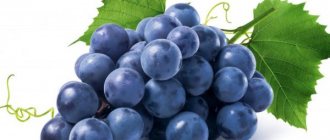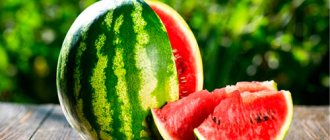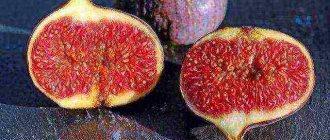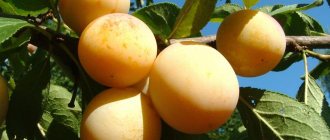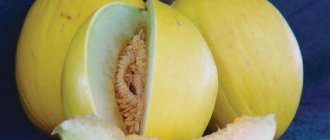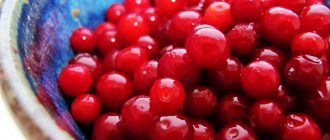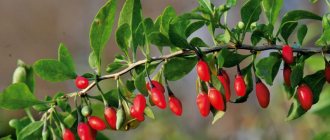What is guava
The exact name of the type of fruit plant to which guava is classified is “Psidium Guava”. According to archaeological data, it has existed and been cultivated on Earth for at least several thousand years. Peru is considered the birthplace of the exotic tree.
The guava fruit is a round, pear-shaped or oval fruit with a yellowish-white, bright yellow, green or reddish skin. Its dimensions can vary from 4-15 cm in diameter.
Guava in cross section looks like a medium-sized tomato. Its pulp is filled with small hard seeds and can be white, yellow, pink or red. Ripe guava smells pleasantly, and sometimes quite strongly, of musk, and it tastes like raspberries, papaya, and a little like melon.
What can you cook
Guava is preferably consumed fresh, but it can also be used to make jam, jam or jelly. In the national cuisines of southern countries, sauces, salads, snacks and drinks are prepared from the fruit. The fruit has a sweet and sour taste that resembles a mixture of strawberry and green apple. It combines harmoniously with spices such as honey, cane sugar, cayenne pepper and allspice. In India, spicy sauces for meat and fish are prepared based on the fruit.
Guava frieze
The fruit has hundreds of varieties that are not similar to each other in taste. Thus, common guava has an invigorating citrus taste. The name of the strawberry variety speaks for itself, and there is also coronilla, Egyptian and Brazilian guava.
Strawberry variety of fruit is suitable for preparing a cooling and nutritious drink.
When creating a cocktail, it is better to follow simple steps:
- Mash the guava pulp until smooth.
- Mix with lime and orange juice.
- Add salt and mix thoroughly.
- Add crushed ice.
- Pour into glasses and garnish with mint.
In reviews on thematic forms, participants note the beneficial properties and pleasant aroma of guava.
Juices, salads and jellies are prepared from fresh fruits. They are added to cereals, puddings, yoghurts and cocktails. And from the leaves of the plant, a healing tea is brewed, which is used for nausea, dizziness and to regulate the menstrual cycle.
Guava and lime frieze
Is there a difference between guava and guava
Guava (guava, guava, goyaba) is a plant and product with a long history. It was first mentioned by the Spanish priest and geographer Pedro Cieza de Leon in his book “Chronicle of Peru” back in 1553. An excerpt from his treatise reads as follows: “In addition, there are pineapples, guavas, guavas (ingas), guanabanas (annonas), avocados and several types of currants, which have tasty peels...”.
And although the traveler in his notes lists the fruits as independent, in fact, guava and guava are two names for the same plant, the whole difference is only in the pronunciation of its Latin name in different languages.
Guava Diet
The low calorie content of guava makes this product suitable for dietary nutrition. If you decide to change your diet in order to lose weight or are going to periodically arrange fasting days, guava is suitable for you.
It has no contraindications (except for individual intolerance) and easily replaces breakfast, lunch or dinner. This fruit:
- Neutralizes the feeling of hunger for at least 4 hours. This long-lasting effect is associated with the large amount of fiber in the fruit pulp.
- Dulls the desire to eat baked goods and sweets. Guava itself tastes sweet. By consuming it, you will forget about high-calorie confectionery products.
- Improves mood and causes a feeling of vigor. The fruits of the plant contain useful substances and vitamin C in large quantities. These components help get rid of depression and feel an influx of new strength.
A guava-based diet involves more than just eating fresh fruit. You can make an extract (juice) and mix it with milk. This drink is very tasty and healthy. The fruits can be mixed with biokefir, low-fat yogurt and oatmeal.
Where and how does the fruit grow?
In nature, guava trees can be found in all tropical regions of the planet; they also grow in some subtropical areas of Asia, Africa and America. Usually their height does not exceed 3-4 meters, but some specimens grow up to 20 meters in the air.
The guava tree is evergreen or semi-deciduous with spreading branches and large oval leaves of a dark green color. The plant blooms 1-2 times a year: small, single, very fragrant flowers with white or greenish petals and numerous long stamens bloom in the axils of the leaves. Later, in their place, fruits appear that look like berries, with thin, bumpy skin and loose, sweet pulp.
Guava prefers hot and humid climates, but is also suitable for indoor growing. Plant seeds can be purchased in specialized stores (for example, the Tropicana variety is quite popular). Caring for an exotic tree growing on a windowsill is the same as caring for other house flowers. It is only important to regularly replant it in containers of a suitable size so that the roots are not crowded and have enough nutrition.
Guava season in Thailand
In Thailand, guava is sold in all markets all year round. The local population prefers to collect unripe fruits because they are better stored. In Thailand, guava is used as a main dish and dessert.
The main dish means pulp seasoned with pepper or salt. To prepare desserts, ripe fruit is taken, peeled, cut into pieces and kept in syrup. In this form, guava is similar to candied fruits (in appearance and taste).
If you want to stock up on fruit pulp and bring it home, buy dried or dried products. It can be stored for a very long time without losing its beneficial properties and maintaining its aroma and taste.
Chemical composition, nutritional value, calorie content
The guava fruit not only tastes good and looks exotic, in addition it also has a rich biochemical composition. The “berries” of this tropical plant contain:
- vitamins: A, C, K, group B, tocopherols, nicotinic acid, etc.;
- minerals: potassium, calcium, copper, phosphorus, zinc, manganese, selenium, etc.;
- essential oils, flavonoids, tannins;
- fruit acids;
- fiber and pectin.
Nutritional value of fruits:
- proteins – 2.6 g,
- fats – 1 g,
- carbohydrates – 14.3 g,
- water – 80.8 g.
The calorie content of ripe guava is 68 calories per 100 g of pulp.
Popular varieties
There are more than 100 species of this plant. Some of them are bred artificially. The most popular varieties of guava:
- Red Indian is a sweet fruit with red flesh.
- Redland is another sweet guava with white flesh.
- Supreme is a sweet and sour fruit with white flesh. The sour taste is associated with a high content of ascorbic acid.
- Kettley fruits have red flesh and a strawberry flavor.
- Giant - guava with fruits weighing up to 0.5 kg.
- Cas is a fruit used to make cocktails and desserts.
- Coronilla is a fruit rich in vitamin C. Guava of this variety is used to make ice cream and juices.
Beneficial properties of the fruit
Due to its rich composition, guava is very beneficial for human health. Its medicinal properties are well known and widely used in Eastern medicine. Among them are the following plant features:
- the fruit is used to normalize digestion: it helps to gently remove waste and toxins from the body, can stop stomach and intestinal upsets, and has a beneficial effect on metabolic processes occurring in the body;
- the fruits contain substances that help cure coughs that accompany diseases of the upper respiratory tract;
- Guava is useful for type 2 diabetes. Its fruits contain lycopene, a substance that helps the body maintain normal blood sugar levels. The glycemic index of guava is 25 units, although this is not a high indicator, the fruit still contains sugars of natural origin, so before including it in the diet, people with diabetes should consult a doctor (especially for type 1 disease);
- guava leaves also have healing properties: teas and decoctions are prepared from them to strengthen the immune system, restore liver health, lose weight, reduce blood cholesterol, etc.;
- the medicinal properties of the leaves are also used to disinfect and accelerate the healing of open and festering wounds;
- The essential oil of the fruit has a powerful antimicrobial effect - it is used in aromatherapy and in the treatment of viral diseases.
Contraindications to guava consumption and potential harm
Guava is a rather rare fruit for residents of the CIS countries. When you first use it, you may experience food intolerance and the following symptoms: nausea, diarrhea, headache. Therefore, it is better to start with a small piece.
We recommend: 2 simple ways to grow wheat sprouts at home
Tropical fruits have the following contraindications for consumption:
- Diabetes. Due to the high sugar content, guava can cause a sharp increase in blood glucose levels and lead to the development of complications.
- Diseases of the gastrointestinal tract and kidneys (gastritis, ulcers, pyelonephritis, urolithiasis). The fruit contains compounds that have an irritating effect on the mucous membranes. Unripe fruits are especially harmful to sick people.
Guava should not be overused, since just 100 g contains 2.5 times the daily requirement of vitamin C. With an excess of this substance, a person may experience nausea, vomiting, dizziness, rashes and itching on the skin.
Possible harm and contraindications
The fruit has far fewer contraindications than beneficial properties. These exotic fruits are not recommended for consumption by those who are allergic to their constituent components. Unripe fruits should not be eaten by people with kidney disease. The substances contained in them can provoke the formation of stones in the human urinary system.
It is better not to include exotic fruit in the diet of women during breastfeeding - it can cause digestive upset or an allergic reaction in the child. It is also better not to give guava to small children under the age of 2-3 years.
Harm of guava
Guava is not considered a particularly insidious exotic. It suits most Europeans. Restrictions - as with other tropical fruits:
- People prone to allergies should be wary of the rich aroma. Half or less is enough to test personal compatibility with the fruit.
- Healthy people should also not be overzealous when tasting it for the first time: it is unknown how the body will react. It's good if it only costs you an upset stomach.
- Even if everything is normal, excessive consumption (more than a kilogram of pulp at a time) can cause diarrhea.
- Immature specimens are contraindicated if the kidneys or adrenal glands are diseased, or there is a risk of stone formation.
Bones require caution. They are hard and when bitten, it is easy to damage tooth enamel or break a tooth.
How to choose fruits
Ripe and fresh guava is chosen based on the appearance of the fruit: it should have an even color and shiny skin without dents, scratches or cracks. To the touch, good fruits are quite dense, but not hard, and they give off a pleasant, but not pungent, smell of strawberries and musk. If you cut such a fruit, its pulp will have a loose structure, similar in consistency to a sugar melon.
Unripe fruits are hard and sour, while overripe fruits are too soft, covered with ugly spots, emitting a strong “tiring” smell. If the choice is limited, then it is better to choose fruits that have not yet reached ripeness and leave them to ripen for a while at room conditions.
Fruits in Egypt by month
The fruit ripening schedule in Egypt is discussed in more detail in the table below.
| Fruit name | Harvest months |
| Oranges | February, March, April, September, October, November, December |
| Apricots | May June July August |
| Watermelon | April, May, June, July, August, September |
| Bananas | January, February, March, April, May, June, July, August, September, October, November |
| Grape | June, July, August, September, October, November |
| Grenades | January, February, November, December |
| Grapefruit | January February March |
| Pear | Aug. Sept |
| Guava | January, February, March, November, December |
| Melon | June July August September |
| Figs | July August |
| Strawberry | January, February, March, April, May, November, December |
| Kumquat | January, February, December |
| Lime | January February March |
| Mango | June July August September |
| Mandarin | January, November, December |
| Medlar | May June |
| Peaches | May June July August |
| Physalis | January, February, September, October, November, December |
| Dates | January, February, October, November, December |
| Persimmon | July August |
| Eshta | October November |
| Apples | May June July August |
Currently reading: Benefits of apricot kernels
How to store fruits
Ripe guava spoils quickly, so it is best to eat it immediately. If the fruits are still hard and sour, it is better to place them in plastic containers or plastic bags and leave them for some time at an air temperature of about 8°C. In such conditions, fruits can be stored for about 3 weeks. At higher temperatures, shelf life is reduced.
What are the benefits of tropical apple?
Due to its rich complex of useful substances, psidium is recommended for use for the prevention and treatment of many diseases, namely:
- for gastrointestinal problems;
- for the treatment of inflammatory processes in the throat;
- for lung diseases;
- to relieve convulsions and epileptic seizures;
- for heart diseases.
The beneficial properties of guava fruit also apply to its peel: it contains antioxidants in quantities exceeding their composition in the fruit pulp itself. Eating the whole guava, along with the peel, helps relieve pain and spasms, helps relieve inflammation and acts as an antitumor agent in combination with the main therapy.
In addition to the juicy, healthy pulp, the leaves are also used for medicinal purposes. In folk medicine, decoctions of guava leaves are recommended for coughs, oral diseases, and dysentery. Herbal tea made from fresh leaves will help with frequent dizziness and serve as an excellent tonic.
How to eat fruit correctly
Guava is rarely found on the shelves of our supermarkets. You can try this fruit while traveling through Egypt, Thailand, Peru and other countries in Asia, Africa and South America. Guava fruits are usually eaten fresh. Before eating, you can simply cut them into pieces and peel them, or you can serve slices of fruit with sugar, salt, spices and even pepper and soy sauce (this specific treat has Thai “roots”).
Many people are interested in the question “is it correct to eat guava with seeds or do the fruits need to be peeled?” It is almost impossible to remove seeds from fruits - they are too small and there are too many of them. The seeds do not contain substances harmful to the human body, so guava can be eaten with them, although they are very hard, and therefore it is better to swallow the seeds rather than try to chew them - this can harm the teeth.
Locals stew Egyptian and Thai guava and serve it as a side dish for dishes of meat, vegetables and cereals. Jams, jellies and preserves are also made from it. The pulp of the fruit is used to make toast and sandwiches, and guava juice is added to ice cream, drinking yoghurts, milk and alcoholic cocktails.
When going on a trip to Thailand, many people want to try as many exotic fruits and vegetables as possible. This is a great and quite affordable way to get to know something new. You should definitely include ripe guava in the list of unusual products - it will definitely leave only pleasant impressions of itself thanks to its delicate taste, aroma and many beneficial properties.
Use in cooking
The juicy, aromatic pulp of guava is used to prepare many delicious and healthy desserts, side dishes, sauces and marinades for meat, fish and seafood.
- Beat the fruit pulp with crushed ice, add powdered sugar and lemon juice to taste - you get natural ice cream
- Delicious jams, preserves, jellies and marmalade are obtained from peeled and seeded fruits.
- Guava is an excellent addition to dietary smoothies made from cottage cheese and yogurt.
- Pulp with the addition of hot Thai spices and coconut milk is an excellent marinade for meat, fish and seafood
- Fruit salad of guava, banana and pineapple is a traditional dish in many Asian countries.
- Unusual marinade for chicken - fresh juice with salt and ground white pepper

